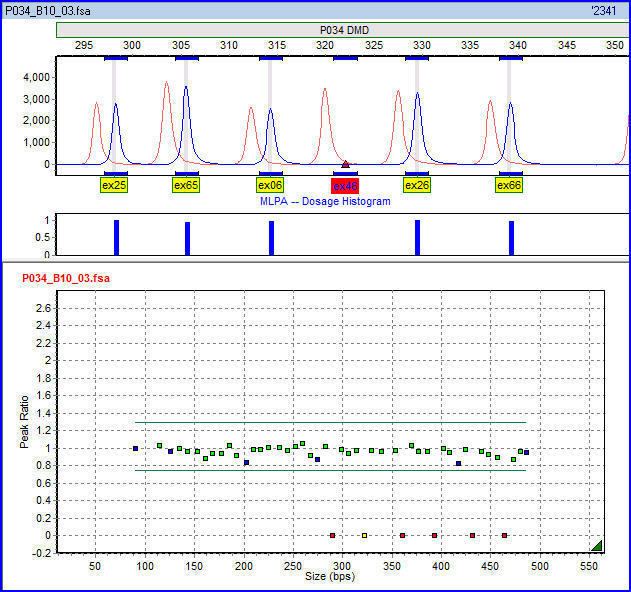 | ||
Multiplex ligation-dependent probe amplification (MLPA)[1] is a variation of the multiplex polymerase chain reaction that permits amplification of multiple targets with only a single primer pair. Each probe consists of two oligonucleotides which recognize adjacent target sites on the DNA. One probe oligonucleotide contains the sequence recognised by the forward primer, the other contains the sequence recognised by the reverse primer. Only when both probe oligonucleotides are hybridised to their respective targets, can they be ligated into a complete probe. The advantage of splitting the probe into two parts is that only the ligated oligonucleotides, but not the unbound probe oligonucleotides, are amplified. If the probes were not split in this way, the primer sequences at either end would cause the probes to be amplified regardless of their hybridization to the template DNA, and the amplification product would not be dependent on the number of target sites present in the sample DNA. Each complete probe has a unique length, so that its resulting amplicons can be separated and identified by (capillary) electrophoresis. This avoids the resolution limitations of multiplex PCR. Because the forward primer used for probe amplification is fluorescently labeled, each amplicon generates a fluorescent peak which can be detected by a capillary sequencer. Comparing the peak pattern obtained on a given sample with that obtained on various reference samples, the relative quantity of each amplicon can be determined. This ratio is a measure for the ratio in which the target sequence is present in the sample DNA.
Contents
Various techniques including DGGE (Denaturing Gradient Gel Electrophoresis), DHPLC (Denaturing High Performance Liquid Chromatography), and SSCA (Single Strand Conformation Analysis) effectively identify SNPs and small insertions and deletions. MLPA, however, is one of the only accurate, time-efficient techniques to detect genomic deletions and insertions (one or more entire exons), which are frequent causes of cancers such as hereditary non-polyposis colorectal cancer (HNPCC), breast, and ovarian cancer. MLPA can successfully and easily determine the relative copy number of all exons within a gene simultaneously with high sensitivity.
Relative ploidy
An important use of MLPA is to determine relative ploidy. For example, probes may be designed to target various regions of chromosome 21 of a human cell. The signal strengths of the probes are compared with those obtained from a reference DNA sample known to have two copies of the chromosome. If an extra copy is present in the test sample, the signals are expected to be 1.5 times the intensities of the respective probes from the reference. If only one copy is present the proportion is expected to be 0.5. If the sample has two copies, the relative probe strengths are expected to be equal.
Dosage quotient analysis
Dosage quotient analysis is the usual method of interpreting MLPA data. If a and b are the signals from two amplicons in the patient sample, and A and B are the corresponding amplicons in the experimental control, then the dosage quotient DQ = (a/b) / (A/B). Although dosage quotients may be calculated for any pair of amplicons, it is usually the case that one of the pair is an internal reference probe.
Advantages of MLPA
MLPA facilitates the amplification and detection of multiple targets with a single primer pair. In a standard multiplex PCR reaction, each fragment needs a unique amplifying primer pair. These primers being present in a large quantity result in various problems such as dimerization and false priming. With MLPA, amplification of probes can be achieved. Thus, many sequences (up to 40) can be amplified and quantified using just a single primer pair. MLPA reaction is fast, inexpensive and very simple to perform.
Applications of MLPA
MLPA has a variety of applications including detection of mutations and single nucleotide polymorphisms, analysis of DNA methylation, relative mRNA quantification, chromosomal characterisation of cell lines and tissue samples, detection of gene copy number, detection of duplications and deletions in human cancer predisposition genes such as BRCA1, BRCA2, hMLH1 and hMSH2 and aneuploidy determination. MLPA has potential application in prenatal diagnosis both invasive and noninvasive.
